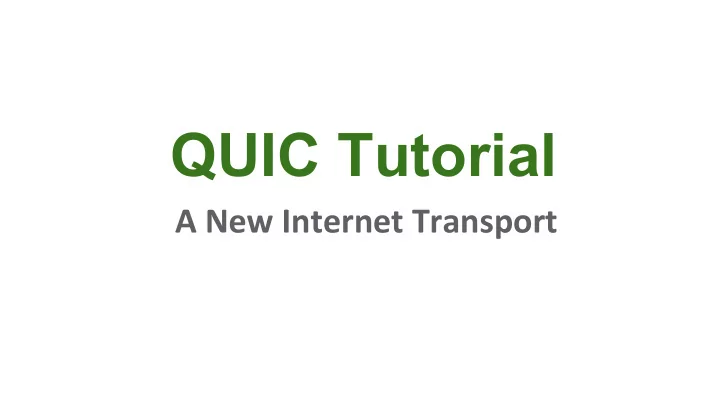

QUIC Tutorial A New Internet Transport
What to expect in the next hour ● Brief history ● Motivations ● High-level overview of work ● Where the working group is today ● You may find this tutorial useful if: ○ HTTP/2 and QUIC are buzzwords to you ○ You can break BGP but think of TCP as too high-level ○ You can write a mobile app in 15 mins but have never seen a tcpdump trace 2
Caveat Emptor ● This is not a QUIC working group meeting ● If you are already participating in QUIC work ○ Feel free to offer clarifications at any time ○ No questions for you! (Wouldn't you much rather be staring at your laptop?) 3
A QUIC history ● Experimental protocol, deployed at Google starting in 2014 ○ Between Google services and Chrome ○ Improved page load latency, video rebuffer rate ○ Successful experiment today ○ ~35% of Google's egress traffic (~7% of Internet traffic) ○ Akamai deployment in 2016 ● QUIC wg formed in Oct 2016 ○ Modularize and standardize QUIC in parts ○ HTTP as initial application 4
What's HTTP/2? ● Q: What does a webpage look like? ● A: Containers, scripts, many objects 5
First, how does HTTP/1 work? ● Connection setup … the long way ○ 1 round-trip to set up a TCP connection ○ 2 round-trips to set up a TLS 1.2 connection ○ (before you rush to the mic, TFO and TLS 1.3 shortly) ● After setup, HTTP requests/responses flow over connection 6
First, how does HTTP/1 work? Client Web Server Can we do better? (Browser) TLS/TCP TLS/TCP 7
Dealing with head-of-line (HoL) blocking Client Web Server (Browser) Can we do better? TCP TCP TCP TCP TLS/TCP TLS/TCP 8
Better handling of HoL blocking: HTTP/2 HTTP/2 stream Client Web Server Can we do better? (Browser) TLS/TCP TLS/TCP 9
How does HTTP over QUIC work? ● Connection setup … the QUIC way ○ 0 round-trips to a known server (common) ○ 1 round-trip if crypto keys are not new ○ 2 round-trips if QUIC version negotiation needed ○ (I haven't forgotten about TFO and TLS 1.3) ● After setup, HTTP requests/responses flow over connection 10
What's HTTP over QUIC? HTTP/2 stream Client Web Server (Browser) QUIC stream QUIC QUIC 11
Old Google QUIC HTTP over QUIC HTTP/2 QUIC QUIC Crypto TLS TCP-like congestion control, loss recovery TCP UDP IP 12
QUIC working group HTTP over QUIC HTTP/2 QUIC QUIC Crypto TLS TCP-like congestion control, loss recovery TCP UDP IP 13
QUIC working group HTTP over QUIC HTTP/2 QUIC TLS 1.3 TLS TCP-like congestion control, loss recovery TCP UDP IP 14
An integrated, modularized protocol Application Application QUIC Crypto handshake TLS TCP-like congestion control, loss recovery TCP UDP IP 15
Hang on … some of this sounds familiar Yes! We're replaying hits from the 1990s and 2000s (and adding some new things) 16
Hang on … some of this sounds familiar TLS 1.3 Ongoing QUIC work uses TLS 1.3 TCP Fast Open (remember T/TCP?) Needs support in client-OS and middleboxes Limited to one packet SCTP, SST, TCP Session, … Shared ideas, but many subtle differences We're happy to steal ideas! 17
QUIC Design Aspirations ● Deployability and evolvability ● Low latency connection establishment ● Multistreaming ● Better loss recovery and flexible congestion control ● Resilience to NAT-rebinding (Connection IDs vs. 4-tuple) ● Multipath for resilience and load sharing 18
Deployability and Evolvability Uses UDP as the substrate enables deployment through middleboxes allows userspace implementation Version negotiation enables protocol wire format evolution Fully authenticated and mostly encrypted headers avoids network ossification befuddles network operators :-( 19
QUIC packets (previous) Version Negotiation Packet (Unencrypted) Flags Connection ID Regular Packets Supported Version 1 Flags Connection ID (opt) Supported Version 2 Version (opt) Supported Version 3 Packet Number ACK Public Reset Packet WINDOW_UPDATE (Unencrypted) Encrypted Payload (Frames) Flags Connection ID STREAM Public Reset fields (TBD) 20
QUIC packets (proposed) Short Header Packets Long Header Packets (optimized for packets encrypted with TLS 1-RTT key) 1 Type (7) Connection ID (64) Packet Number (32) 0 C K Type (5) Connection ID (opt) Version (32) Packet Number (8/16/32) Payload Encrypted Payload Type-dependent (Frames) Not always encrypted 21
Congestion Control & Loss Recovery QUIC builds on decades of experience with TCP Incorporates TCP best practices TCP-like congestion control (NewReno, Cubic), FACK, TLP, F-RTO, Early Retransmit, … Richer signaling than TCP 22
Richer Signaling Than TCP Retransmitted packets consume new sequence number no retransmission ambiguity prevents loss of retransmission from causing RTO More verbose ACK TCP supports up to 3 SACK ranges QUIC supports up to 256 ACK ranges explicit packet receive times enables ACK decimation 23
What's the QUIC wg up to? Turning an amateur protocol into a professional one A QUIC makeover Figuring out how to ○ map HTTP cleanly to QUIC ○ use TLS 1.3 with QUIC ○ resolve open questions in QUIC ○ make QUIC work for non-HTTP apps 24
Is this just Google's QUIC? No. Google's QUIC was an experiment QUIC wg uses the experiment as a starting point Already moved miles away from experiment A great example of running code informing protocol design. 25
QUIC Implementations Chromium (open source) https://cs.chromium.org/chromium/src/net/quic/ quic-go (open source implementation in Go) https://github.com/lucas-clemente/quic-go 26
Debugging Tools: Wireshark 27
Debugging Tools: Chrome chrome://net-internals (demo if time permits) 28
Recommend
More recommend